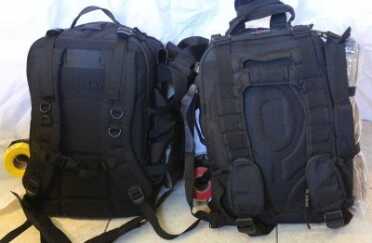
It took me probably twenty hours of research and ordering things to build twin packs for attending to a serious trauma event. You can see the triage tape I covered in a recent article on the sides. On the left is the Blackhawk S.T.O.P. II. On the right is a cheap Chinese copy branded Altatec.
Blackhawk S.T.O.M.P. II:On Amazon $217
Backup Link: On Amazon (Optics Planet) $224 + shipping
At Blackhawk: S.T.O.M.P. II Medical Coverage Pack
Altatac Everyday Carry Medical Backpack
Blackhawk Medical Litter: On Amazon $48
Are you a hero? I’m just asking because as much as I hate it, I probably am. It is so stupid from a survival perspective to rush in to the face of a disaster to help people, but the reality is, most of us reading this column are going to do it. So if you believe that there will be an event of some sort to distract the sheep away from who caused this mess, it might help to buy some trauma bandages and learn how to clean wounds now. There is no worse feeling than wanting to help but not being able to do so because you lack the proper tools. It also sucks for the people who would be trying to help of course. You can pull off your shirt, rip it, tie it as a tourniquet, then use a stick to tighten it. But after a couple of those, helping people naked is just asking for trouble. You could use their shirt duh, but how hard is it to get a shirt off of someone screaming in pain? Wouldn’t it be better to get a few tourniquets in advance?
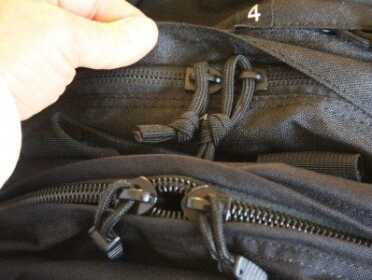
The street price of the Blackhawk pack is roughly three times the street price of the Chinese pack, but though they look similar and have similar storage capabilities, the Chinese pack, shown on top here, has cheap zippers that will fail in a crisis. Hey, if it’s all you can do, just be careful with the zippers, but if you are a high budget prepper, the Blackhawk pack is worth the investment.
This is a followup to my comprehensive yet rudimentary first article on Survival Medicine, which is the title of the book in that article that I recommend, and that I still recommend. All of the stuff in that article is still available, though the websites from India where you can order antibiotics seem to get taken down as soon as they go up these days. Our wonderful government needs billions of dollars in law enforcement spending to fail at stopping underage porn online, but when it comes to the medical establishment retaining their control of our health, they just shut the damn websites off. Pet antibiotics are still available, but they aren’t the most updated.
The only thing that I left open in that article is trying to construct your own medical trauma kit rather than purchase one already built. No matter how you slice it, a medical kit is going to be expensive. I decided to go back to this subject after reading Steven Harris’s list of first aide kit products (we covered his solar heating books last week). He has some great things on there like diaper rash cream and Tinactin, some of which I still haven’t gotten for my rather large stock of OTC first aide products. I spend hundreds of dollars at Walgreens getting a supply of everything from Tylenol to Immodium, but I did not buy any Tinactin.
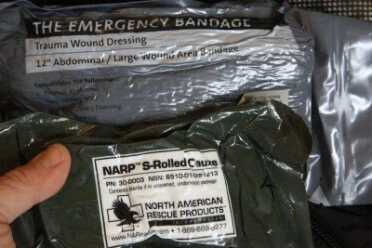
The most important item in a trauma pack is a lot of high quality bandages. There are a ton of surplus bandages on the market today. You just have to do the research.
What Steven overview doesn’t cover, and what most people don’t cover, are the tools that EMTs and the military uses to stabilize people with heavy trauma. You may say that in a survival situation, if someone has a sucking chest wound or a leg blown off at the thigh, they ain’t going to make it. But what if that person is the neighbor you were at this past Sunday for a barbecue, or your kid’s school teacher, or G-d forbid someone from your own family? You are going to try to save them, and if you don’t educate yourself now as to how to do potentially do that, and buy some of the tools, it isn’t going to end well. We are all on a limited prepping budget, and every dime that you spend not on storeable food is a pretty serious dime. But like with everything else in this column, you have to ask yourself what is more likely a need you won’t want to be without.
Do You Need a Specialized Pack?
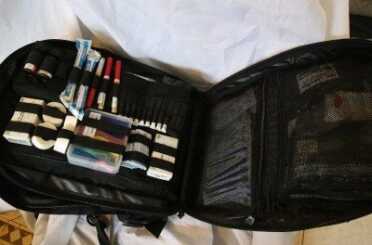
This type of setup is so much superior to throwing everything in a duffle bag that it is worth paying slightly more to get a pack meant for field hospital work. This is the Blackhawk.
My original thoughts on needing a specialized pack were negative, but my thoughts on all expensive specialized nylon packs are always negative. I’m the guy who is going to buy the cheap tactical gun case from China at the gun show that the zippers break on. I also don’t really prioritize organization. Throw everything in a duffle bag and we’re good to go. That got me to thinking. Maybe for this particular application, my general modus operendi isn’t appropriate. You won’t find a pack for sale online that has all of the stuff I am going to cover, so you are stuck building it yourself. If you have the budget, I would invest in a good compartmentalized pack.
For this article I decided that backpacks are superior to the compartment duffle bags you see carried by most EMTs. An EMT can 99% of the time assume that their ambulance will make it in, and that they won’t have the hump the bags. A good backpack like the ones I chose can be carried by handles, but you can can also put them on your back if you have to carry them in should traffic be deadlocked. In your hands you could carry water, food, or even a rifle. Granted, those EMT bags generally have a slot for an oxygen canister, but I wouldn’t waste the pack weight on it for survival of heavy trauma.
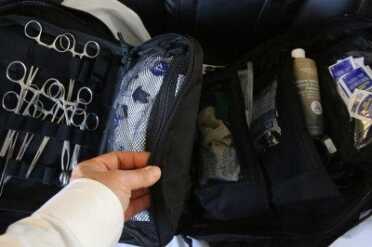
This is one of the slabs of he Altatec pack. Inside the two packs are different (see the sales pages), but functionally I fit about the same amount of stuff.
The first was sent as a review product from Blackhawk. I looked over their product pages on medical packs and decided on the most expensive one lol, the $347 MSRP S.T.O.M.P. II Medical Coverage Pack. (they are selling on Amazon significantly less) In fairness I did also ask them to send one of the cheaper models, but they said they could only send one, and a litter. So though I don’t plan to jump out of perfectly good airplanes anytime soon (the pack is “Jumpable”), what would you do?
If you have never compared a Blackhawk pack to cheap Chinese copies (and yes, I did buy one of those too), they may look close to the same, but I think the Blackhawk a cut above. The S.T.O.P. II is 1000 Denier Nylon, and the stitching is very heavy thread in multiple rows for reinforcement. This pack was made for SEAL team medics, so it is built to withstand a lot of abuse. There are plenty of people who read this column who are on high budgets, and I have to say that if you are going to go and build a kit like this, don’t think twice whether the Blackhawk S.T.O.M.P. II is the best pack for the job. See the pictures for the compartments, and it comes with two extra bags, only one of which I used.
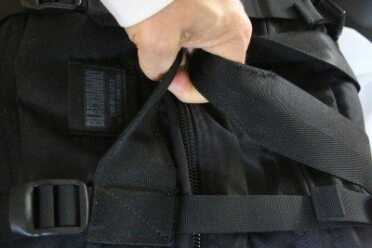
I prefer the Blackhawk top carry system as compared to the Chinese pack, which incorporates the shoulder harness. The Blackhawk also has a waist belt, which makes a big difference if you are dragging someone.
The other pack I found from Altatec on Ebay for $72.95 shipped, and I have to say, it is no slouch. They call it the Everyday Carry Huge Tactical Corpsman Backpack, and I would say that they were copying the Blackhawk in building it. This pack also comes with two extra bags, and it claims to also be made of 1000 Denier Nylon. Physically it is nearly identical in size to the Blackhawk, but it lacks a waist belt (not jumpable lol). Both packs also have a drag strap system that you can use with a litter, which we’ll get to below, but the design of the straps and the overall feel of the shoulder carry system, with a waistbelt on the Blackhawk, is much better on the more expensive pack. Of course you could buy the Altatec pack and a ton of supplies if you are on a budget, as compared to the Blackhawk.
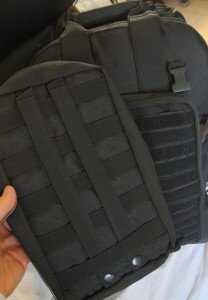
Both packs came with two extra bags, and in both packs I used one of them to hold my burn dressings, and didn’t use the other. One nice feature of the Altatec bags is that they have MOLLE straps on the back for attaching to anything.
If there is a huge difference between the two, it is in the beefiness of the zippers. The Blackhawk zippers don’t catch as you open and close them, and with the tunnel vision of a survival medic situation, that is a big deal. The Altatec zippers are smaller, and they are covered. That cover, while possibly providing some water resistance, does catch when you try to do the zippers quickly. I found that I could practice with the zippers and they don’t catch, but if the “event” happens a year from now am I going to remember? I’ll probably have to deal with zip covers caught up in my zippers.
I try not to give a lot of actual advice in this column, but in this case I can safely advise you to beware of smaller packs. Altatec makes a smaller pack that is used in a lot of the “trauma kit” pre-made packs on Ebay. I started with that pack myself, as a pre-made kit. I think they are fine if you just want a basic kit with one of each thing to carry in your car. If you happen upon a car accident, the chances of more than one person needing an airway are slim. But if you want to carry 30 of the Israeli blood stop bandages and 10 nose trumpets and a big bottle of iodine, etc., you are always going to wish you had more space.
Another example of a small car kit would be the military 7M09 Medical Kit. I bought one and stuffed it with extra Israeli bandages for my car. It’s got all the good stuff not in most first aide kits that are listed below. Then there are intermediate sized kits, and you’ll find that each branch of the military has their own version. Even on these big packs I find myself saying I wish I could fit more of something, like cold packs, sterile water bags, and yet more bandages, so if you are serious about a pack that you can walk into hell with, beware that you are going to need more space than you have, even with the biggest packs.
Stocking Your Pack
There is no mystery to most of the stuff you need in a medical pack. Your job will be to stop the bleeding, then clean and bandage the wounds. But there is a list of specialty equipment.
- Blood Pressure Cuff & Stethoscope – I covered this in my last article. One of the telltale signs of survivability is the person’s blood pressure. Even in war, the most common type of life threatening trauma is blunt force injury, like being blown back my an IED, or having part of a vehicle or building fall on you. As I explained in my recent article on triage tape, diagnosing the injured and labeling them for transport is going to be a big part of your usefulness. Electric BP monitors are great for home use, but a manual cuff and stethescope are going to be far less prone to breakage and failure, and you can get sets on Ebay for under $20 that work great.
- Blood Stop Powder – The most common use for styptic, hemostatic, or “blood stop” powder is for dog grooming. It is not unusual to cut too far up a dog’s toenail and that makes it bleed. Groomers apply some blood stop powder, and it saves a lot of mess. For people, “Quick Clot” is the company that supplies the military, and that you can buy in the consumer market. Quick Clot is made from Zeolite, which is a porous rock used for purification of a lot of different things. You can find several different types of blood stop powders on Ebay for a very wide range of prices. I don’t know how effective they are compared to Quick Clot. They are certainly much cheaper. In non-consumer, military and industrial packaging, Quick Clot is much cheaper, like $7 for 100 gram packages. I think it is a must have.
- Trauma Bandages – The other absolutely must have are a lot of combat bandages. There is nary a prepping article in the world that won’t suggest the Israeli military trauma dressing, because they are so heavily oversupplied for both Israeli and US military use, leaving plenty for the grey consumer market. The most common size is 4 inches, and in this terrible economy, those are going for only a few bucks each these days. The larger 6″ size goes for a little more. The nice thing about these dressings is that they are impregnated with hemostatic powder already, and they come with straps, eliminating the need or tape as with common sterile gauze dressings. Buy as many of these as you possibly can. In lots of 30 or more they are currently under $2 each including shipping. I also found some 12″ for about $6 each.
- Tourniquets – By far the highest mortality rate on the battlefield is due to limb loss. The femoral artery in the leg is like a garden hose, and the injured person can bleed out very quickly. Luckily it doesn’t take big technology to save a person who has had major blood vessels severed in the extremities. If you do a regular search for Tourniquets on Ebay, you’ll get mostly hits for a military version called the “red tip tourniquet.” They go from $7-$15 each, depending on where you get them from and if they have the military NSN markeings.
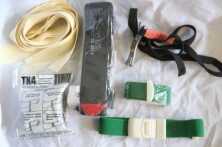
These are the different tourniquets you’ll find for sale on Ebay and Amazon. The “red tip” is the most expensive, and it doesn’t use a stretchy material, making it more reliable.
That tourniquet is great because it has an integrated tightening rod, and it doesn’t rely just on elastic material, which can break down after sitting for a time in a pack. Cheaper than those are H&H tournequets, which are just a rubberized cloth with two hooks, simple yet effective, and even cheaper are the tourniquets used by flobotomists. They have a plastic buckle release. You can also get natural rubber tubing by the foot for less that a dollar per tourniquet. It all boils down to what is your budget and how much time can you spend on ordering things in for your pack. I found a pack of 10 flat rubber tourniquets for $6 on Amazon. You can get the colored ones with the buckle for a buck each. - Airways – A funny thing happens I guess when you get knocked unconscious. The back of your tongue can actually block off your air, so most good medical kits have some sort of airway. The military uses a Nasopharyngeal Airway, which is a rubber tube that is pushed through the nose down into the back of the throat. They are also called a nose trumpet, and they are only a few bucks each on Ebay in quantity. The other type of airway is the kind you see in EMT kits.They are called a Berman Oral Airway, and they come both in a kit with several sizes, down to small child, and I see them in bulk in just adult size. I have one of the many size kits in my pack, and some nose trumpets. See the Youtube videos on how to insert both types of airways. This is not what they call Intubating. I actually bought a laryingeoscope in hopes of learning that but I haven’t gotten further.
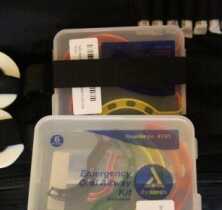
Click the links in the article to see the different types of airways. These are preferred by EMTs, and the Military seems to prefer “nose trumpets”.
- Chest Seals – There are two camps it seems when it comes to the best way to patch a sucking chest wound. The old traditional way to seal the wound was to use a sticky dressing and leave one side not taped. That would give the blood something to clot against without cutting off the ability of the chest to expel gas from leaks in the lungs. The problem with this is that the chest can also suck stuff in, which is nasty. To deal with this a military contractor company called H&H created a chest seal with one way valves. The chest seal is a big gummy sticky thing, and the wound can breath out through the valves, but can’t breath in stuff that would contaminate the inside of the person. I found some on Ebay for as little as a few bucks each.
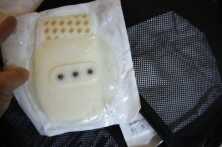
This is a Bolin/H&H chest seal, with vents to prevent the chest from filling up with air from a collapsed lung. The Hyfin chest seals are just big 4 sided bandaids, but someone got paid to put them in current issue Military kits.
According to the Hyfin chest seal video on Youtube, that thinking seems to have reversed itself completely now. The military kits currently have a Hyfin Chest Seal, which is just a big bandaid with 4 sticky sides. They run about the same price on the surplus market, just under $10 each. - Tension Pneumothorax Needle/Catheter – Wait! Don’t run away screaming yet! This isn’t as complicated as it all sounds, and every battlefield trauma kit has one of these things in it. One of biggest reasons people die from blunt trauma wounds is that they break a rib, and it punctures a lung. This causes the chest to pressurize, and that pressure can make it so that the organs in the chest cavity can’t function.
It used to be that they would put in a chest tube, which is a semi-complex minor surgery, but at some point, as a bi-product of our endless wars and the resulting casualties, someone figured out that you could just use a 14 gauge needle to vent the chest, and that a soldier could even do it to himself in the field. You just locate the 2nd rib space and stick it in, then remove the needle, leaving the catheter.
The kits go for $10 each or so on the surplus market. Occasionally you see them cheaper. See the video to the right on how they are used.
- Splints, Duct Tape & Zip Ties – The military supplies a SAM Splint with most of their kits. They take up about the room of two ADB bandages each, so it is decision when you are dealing with cubic inches. They are as little as a few bucks each on Ebay. I personally put one per kit. I also hang a roll of duct tape from the outside straps of my packs, and I also carry industrial sized zip ties. Both of those things can double as a tourniquet as well. If you have duct tape you can really use anything as a splint, but Murphys law don’t forget.
Burn Dressings
One of the more expensive components of your pack for which there is no cheap substitute are burn dressings. If you look through what comes up on Ebay for “burn dressing” you’ll see both wet and dry options. The wet option is from Water Jel. They make both big and small bandages soaked with lidocaine, and I got some for my pack.
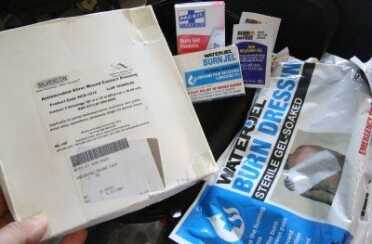
These are the most common burn dressings you’ll find. They ain’t cheap. Those packets all seem to be the same Lidocaine/Benzocaine’ish jell.
I also got some of the H&H dry burn dressing called a “cravat,” which is also a sling, and a tourniquet if need be. The very expensive option is called Silverlon. It is impregnated with colloidal silver to stop bacteria growth, which is the primary danger with an open burn. I got a couple of those too. At some point you do have to ask yourself, should I get 5 6×6 Silverlon dressings or another 50lb bag of pinto beans, but whatever.
The different brands of “burn cream” are mostly just sterile Lidocaine. For minor ouchy burns and sunburns, , packets of Burn Free will do the job.
Wound Cleaning
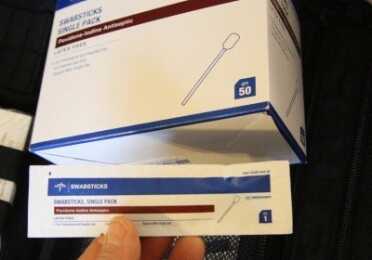
Unless the patient is allergic to shellfish, iodine is the best way to clean wounds. These sticks are cheap when purchased in bulk. You can also get iodine pads, and both big and small bottles for washing hands and instruments.
Once a wound has stopped bleeding, by far it is as important or more important to clean it than it is to bandage it. We have a natural desire to close an open wound, and if you trap dirt and bacteria in there, it will fester as the material around it tries to join and heal. This creates an infection inside, one that can kill you. Unless the person is allergic to shellfish, the best way to do this is with iodine. It doesn’t sting, and iodine is a strong antibacterial. I prefer iodine swab sticks, and the best buy I have found in my travels is on Amazon, $48 for 500 of them. Now 500 is a lot. The individual boxes of 50 are about 8″x 4″ x 4″ and you won’t fit more than 50 of the sticks in your pack. I would just box them and put them away in your survival storage. The sticks will also work as water purification, and you’re always going to have booboos to clean.
I also found small bottles of tinture of iodine in plastic for only a few bucks each, and for big wounds before you put a bandage they are well worth the investment.
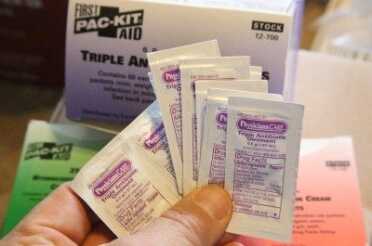
You can get triple antibiotic ointment in packets from Pac Kit, along with Zinc Oxide, and burn cream. Amazon carries all of the industrial Pac Kit supplies.
You can also initially clean the wound with water of course. Both of these packs have attachment points on the outside, and you can attach a military canteen if you wanted, or even just regular water bottle holders. You don’t need sterile water to clean wounds, but if you are going to suture, it might be worth it to have some sterile water as part of your pack. I don’t, because the only difference between sterile water and bottled water is that sterile water is heated to over the temperature that kills botulism, under pressure. Regular bottled water is UV or gamma sterilized. I am also not a fan of the bagged “survival water,” because you can’t recap it.
Litters
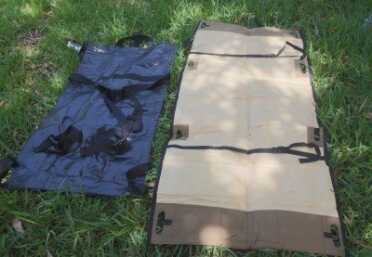
On the right is the Blackhawk litter. On the right is the litter with the “wee wee pad” absorbent top. The Blackhawk litter has tie down straps so you can drag the patient alone.
If you look in the pictures, you’ll see that I included two types of litters in this project. Blackhawk sent me their medical litter, and they sell that on Amazon for $48 right now. The only cheaper option I have seen is a US Marine Corps canvas litter that actually has absorbent “wee wee” type of pad on one side. It’s kind of yucky I don’t know why you’d want that. The Blackhawk litter is the opposite, shiny waterproof. I’d get that.
I think a litter is an absolute must for a pack. Both of the bags I show here have a double drag strap system, and it is hard to drag someone unless you have a litter to attach them to. Rigid litter kits are very expensive. The NARP Talon II, even surplussed, goes for $100 and more for just the litter, and the bag for it is usually close to that as well. Loaded with goodies, the whole kit sometimes goes for $500.
Suturing
There is what I would call disinformation in some of the survival medicine books that you shouldn’t attempt to suture wounds. They assume I think that at some point, you’re going to go to a hospital. My take on it is that if you are preparing for a grid breakdown, you had better have some sutures, and learn how to suture. Just beware that the key to not making things worse with suturing is to clean the wound really well.
I am just getting into learning how to suture myself, so I’ll update you with that if I have time, which is getting short I think. There are a number of good Youtube videos on it, and I bought this $69 learning kit that includes practice skin. If you look on Ebay, there are a ton of people selling survival medical kits that have sutures in them. I strongly suggest that you buy your suture kit from this guy. Look at the pictures. And if you are going to make your own kit, there are plenty of 12 packs of sutures of individual sizes on Ebay. The name brand company is Demetech. There are cheaper options though. And beware that there are absorbable and non-absorbable sutures. The latter tend to be stronger, but you have to cut them out. If you are going to order just one size, I would get absorbable, in either 3/0 or 4/0 in the 18″ length. You can research it yourself. Just beware that sellers on Ebay will list them as practice, dental or veterinary sutures, because they are supposed to be RX only. Sutures are sutures are sutures. They boxes don’t say anything different.
If you can, try to get some injectible Lidocaine from your doctor. There are some sellers on Ebay that have it as a bonus when you buy other things, so check the photos. Just beware that you have to do your homework about how to use it. My preliminary research has shown that if you don’t draw first to make sure that you aren’t on a vessel, you can kill the person. Also, some Lidocaine has Epinephrine in it, to stop bleeding. I don’t know what the additional dangers it poses. From what I have seen, you draw from the bottle with an 18 gauge needle and inject it into the sides of the wound with a 25 gauge needle, working up so only the first needle prick is felt. This is of course at your own risk. I’m not advising you to do anything if you are looking for someone to sue. Lidocaine is also a big deal for extracting a tooth.
Food & Water
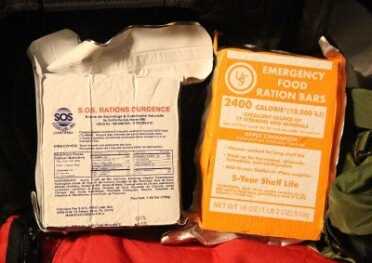
There are a number of 2400 and 3600 calorie food bars you can get at Walmart (right) and on Amazon (left) to include for yourself in your kit.
In any mass casualty scenario, there just aren’t going to be enough hands. You should include in your pack either a canteen or bottled water that is just for you to drink, and some sort of survival food that isn’t going to go bad or turn to dust several years down the road. I am personally carrying a couple 3600 calorie bars in my packs. They are about $6 each in quantity, and I don’t think you could get more calories in $6 worth f Snickers bars or really anything else. These bar blocks are indestructable, and vacuum packed for at least 5 years of shelf life, probably more. As a regular survival food they no slouch in cost per calorie. A 50 lb. bag of dry pinto beans is about $50, for 50,000 fairly substantive calories. These bars are mostly flour and sugar, but $115 20 pack is 72,000 calories, not comparably bad, especially when you factor in that you don’t have to cook these, and that price is shipped.
Misc. & Etc.
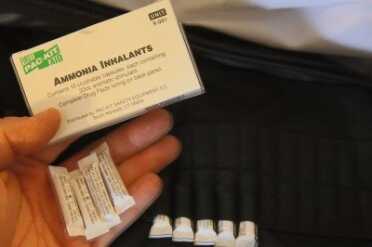
As you add some of this stuff to your cart on Amazon, other stuff is going to come up that is cheap and that you need, like these ammonia inhalants.
This article already has way too many links that only a handful of people will follow, so I’m not going to link out to a lot of other little things that you can consider. Steven Harris’s page, liked above, has a lot of things that are musts for a camp first aide kit, but may or may not be worth the trouble of putting into a mobile trauma hospital. If you are just trying too cover your bases, Amazon is a great place t find bulk packages of everything from zinc oxide packets to snake bite and eye wash kits, which you will see in my pictures here. The “people have also viewed” feature on both Ebay and Amazon is really valuable in these types of projects because it’ll show you where there are sizes that might be the same price with twice as much. I have probably 20 hours into this article, FYI. You have to do your homework, and I hope I have saved you some trouble if you want to go down this road. Also check out my prior article (especially about the antibiotics) and Steve Harris has some very basic knowledge about how to buy bandaids on Amazon (lmao). The trick is finding the time and money to buy all this stuff.
And as with many of these articles, I’ll say that ideas like this kit are great brain food when you think about prepping, but if you don’t have sufficient food and water at the ready, there is no way you should be putting money into these things. What is sufficient? A year is not crazy, I can tell you that. And if you have a lot of people in your group, that’s a lot of food. I’ve written so many of these articles that I have the luxury of spending money on projects like this because the company pays for them. I hope there is no disaster for this fool to rush into, but in case there is, I am as well supplied as anyone. Now I have to just learn how to do stuff lol.

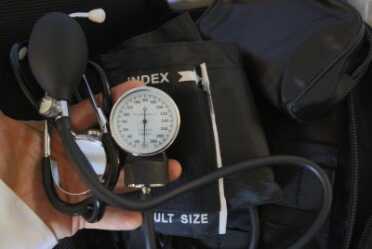
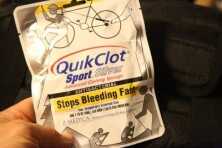
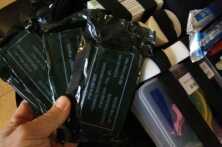
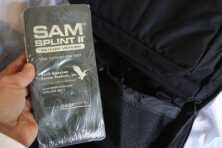
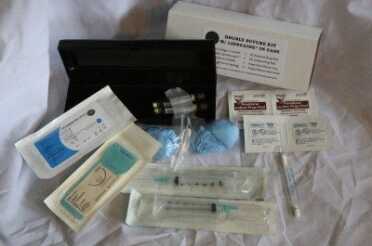

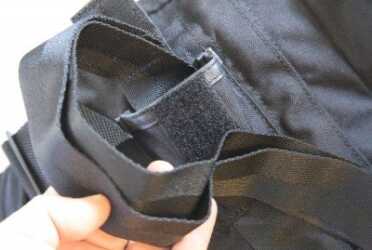
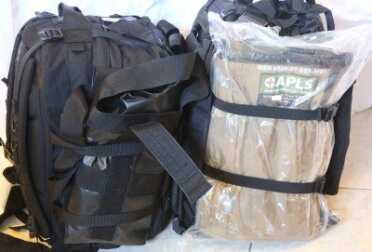
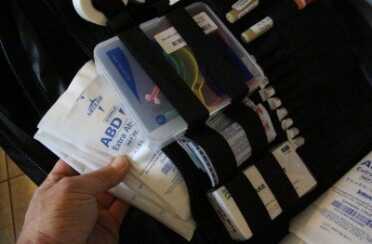
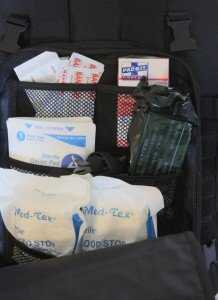
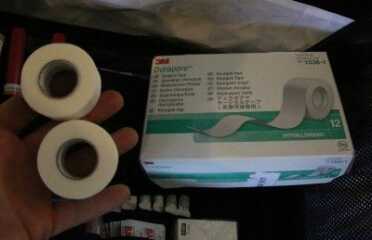

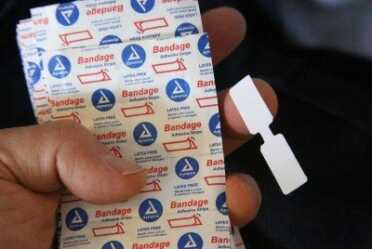
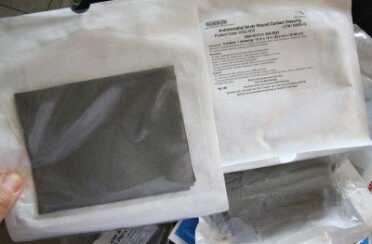
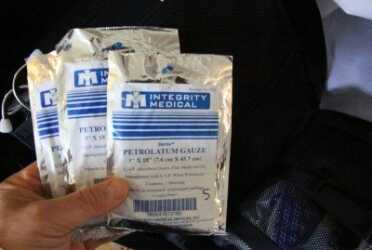
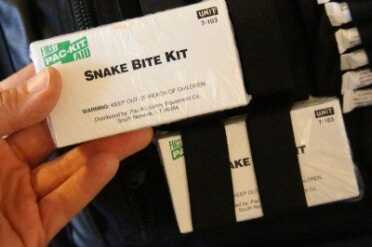

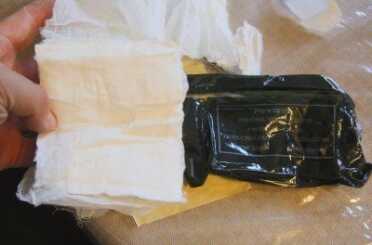
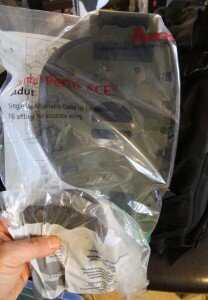
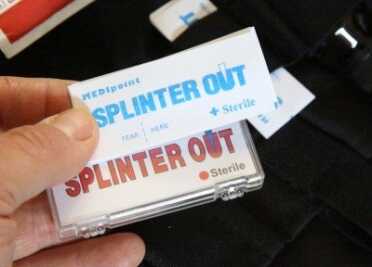
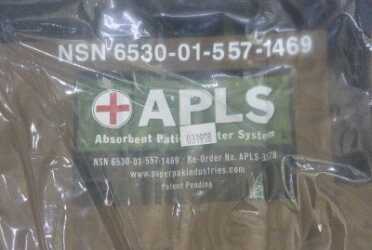
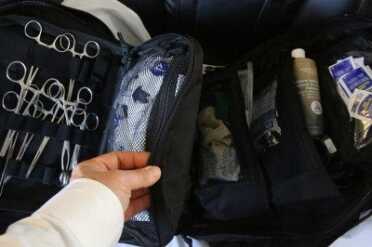
Didn’t see how long ago this was posted but the quick clot powder is hard to use wind blows that shit everywhere it burns like a bastard and if your hands are wet or sweaty it will do the same thing to your hands and burn the shit outta them… Quick clot makes a gauze now… So much better has the same stuff Kaolin but the gauze is impregnated with it.
I agree that you need the appropriate medical training/certification (in most every situation) in order to use/perform certain activities.
I personally lean towards stocking things “above my pay grade” because the kit/items are primarily for me and/or loved ones and I’d be hoping that a highly trained individual would happen to be present to make use of it if needed.
Sidenote on EMT gloves: I think the newer Black nitryl Gloves are nice and could serve a tactical purpose as well.
However, I’ve seen/read some EMT comments about their use at night or in dark/shady conditions making it virtually impossible to “see” blood and/or differentiate its amount.
Cheers
Harv
Ok, I’ve re-read this a couple of times thinking OK HOW CAN WE HELP? The author is SO far off, and now I see the title is something about how to build a ‘Mobile Emergency Surgical Hospital’ or something like that – and it seems to start with a re-re-cycled article. There are also a few folks here worth listening to. Most say: don’t do this stuff you’ll kill someone. What they mostly mean, I think, is you’ll just kill people faster. (some maybe slower, and others will did cause nothing was really wrong with them except they need water, food, and rest. KiloCaloris will only work for a while, then you die from malnourished. So here’s an Idea where we can all help each other. Each EMT, Paramedic, RN, Corpsman or Medic gets to pick ONE item – only ONE and put that into a ‘trauma pack’ — and explain how it can be used to ‘save a life’. I know it’s hard. I want TWO things right off the bat, but I can only have one. Here is my pick:
ROLLS OF ACE BANDAGE.
Why? Because it can be used as a tourniquet right off the top. That is where most of you immediate blood loss is going to happen, and an Ace bandage can be wrapped in so many kinds of ways, it’s bound to fit over a pressure point, or be able to become a pressure point by holding something down that WILL constrict most arteries-veins even if they are deep and proximal to the wound or the part of a person that ought to be there.
They can be made into slings, they can be used to, immobilize a joint or parts of a body that need to be constricted (for sprains and strains) – They can be lashed to sticks or ‘ladders’ to become splints, they can be used to hold on homemade battle dressings (and I’ll wait for someone to bring up pampers as Battle dressings), they can be used to hold pressure on a deep wound with nearly anything clean shoved down into it, and then help TIGHTLY in place by the ACE. Be the wound in an arm, thigh, abdomen or chest — they can be tied together, or ‘hoked’ together, and made to keep abdominal parts where they approximately belong, and can be Gerry rigged for multiple kinds of chest wounds, or shoulder (puncture or fx bones) – they can even be used to help keep lose pieces of clothing together to help keep that ‘C-collar’ in place without compromising blood flow to the brain.
Because they and change shape (they are shape-shifters) and conform to nearly ANY deformed part of the body – they can be wrapped around a hand or foot and used with something that approximates a tension split and yet not cut off blood flow distal to their placement.
They also allow for a minimally debrided wound to be opened GENTLY to check for spread of sepsis, or allow FOR sepsis where that not possible before moving the pt- and it allows for a drain or wick to be inserted without the damage done by having to pull on Duct, Athletic, Adhesive, or other kind of quick-closure dressing. It allows for creating or making and maintaining a ‘clean’ field around the wound (notice I don’t say ‘sterile’)-
It can also be used to ‘stabilize’ a pt on a stretcher, tarp, or some kind of travois should the pt need movement from one environment to the next. It can immobilize a jaw, or allow for the attachment of a severed nose or ear if you are lucky enough to find it, keep both sides clean and have it lined up as well as you can in the field — AND, of course it can be used to simply slow down O2 to the brain so death comes as the on-set of induced sleep and can be very much less painful if you don’t happen to have MS around, or the MS needs to saved for pts more in need and ammo is at a premium or can’t be used for other reasons. It can hold a jaw closed and it can hold a jaw open.
So, in short the ACE bandage can be though of as a one-size-fits-all variable pressure re-usable bandage.
So, there you go – MY contribution to a Trauma kit when the rule is that you can only pick ONE piece of equipment and justify it’s use. I started with Zero, which makes it both very easy but also VERY difficult when you go down the list of all the things you really DO need — but let’s build a very real and very useful ‘Trauma’ kit for these guys. God only knows how much crap this guy is carrying that he can’t use. Or will never remember how to use and hopes that one of US comes by and assuming we don’t take it from him — and set down OUR GOOD bag and give a hand.
WHAT’S NEXT AFTER SEVERAL ACE BANDAGES? Cone on guys – let’s mount up, dust off, and show these guys how to put a good trauma kit together for when it’s time to GOOD.
(And if what I learned at Great Lakes was true – that Betadyne kills EVERYTHING in 10 seconds or less – why didn’t we spary THAT out of our our planes rather than Agent Orange? Hell it’s almost he same color when you get down to it!) sure wouldda made a real short war! eh?) —
OK, WHO’S NEXT – REMEMBER 1 AND ONLY 1 ITEM !!!!!! — And explain why you picked that over other items so others can learn. And DO get absurd at times – I mean – re-attach a nose or an ear? REALLY? (WELL nah, but if you are really quick, you COULD do it with only a blood supply, probably never neurological connections, but vascular? heck maybe; might even be close to 50-50 if you were right there and did it REALLY fast and kept it clean!) – so come on – WHO’S NEXT!!!??
I believe the point is that professional medical attention may be days, weeks, months or never. Better to have some supplies & mental training to survive.
I teach first aid/trauma to chain saw operators and I’m an EMT/firefighter and took Tactical Combat Casualty Care.
You know what I carry? CAT tourniquets, gauze, OLAES pressure bandages.
With the “red tip” CAT tourniquets, the cheap ones you buy on ebay for $15 are knockoffs from Hong Kong made for Airsoft enthusiasts. The real deal are bought directly from NAR for about $25-$30. I’ve played with the knockoffs and they don’t work well. I absolutely would not use rubber blood draw hose to stop bleeding from a severed artery.
So many people in the prepping world focus on having the tools, but they don’t know how to use them. A lot of the stuff in the author’s kit is actually restricted (such as chest decompression needles) and not meant to be bought by laymen without the knowledge of how to use them. The idea that the author has a scalpel and intends to use it without formal training is terrifying. Paramedics, who have over two years of medical training including 600 clinical hours in a hospital ER, do not cut people open. This stuff isn’t the movies.
There’s a lot of misinformation in this article. It’s irresponsible of these people to publish it.
My only advice is sign up for EMT classes at your local community college or take certification classes if you want to learn how to help. If you’re not trained on a procedure you should not be doing it. Christ.
I am no med tech but, I have to agree. For most of us, the basics of first aid, stop the bleeding, protect the wound, treat for shock, is as far as any of us can or indeed should do.
Now, if a person wants to get some advanced training, then that’s great. That training will also include the knowledge of it’s limitations.
As an aside, I took a look on ebay and those IDF bandages are going for $5 or $6 bucks apiece now.
Double D, Real Johnny Gage, and Fran the RN are all right. Meaning correct. Remember that Corpsmen, Medics, Paramedics, EMT’s all do their work IN THE FIELD (which is where all of this is going to happen). I happen to have MANY skills that an MICRN (Mobile Intensive Care RN and an Flight Certified RN has)- as does the Army Medic, and a few Paramedics. In The Real World, I was a teacher. Just watching a video is NOT going to cut it. There is a ‘feel’ to what you do. It’s that ‘feel’ that guides you. Getting a good flash-back takes FEELING — not a video. (all of us remember how black and blue and sore our arms were when we learned to do sticks – it’s an ART – a video won’t work. Same with all of the other things – What kind of blade did you get with your laryingeoscope? It it came with more than one, which would be your blade of choice? Did you know that you could cost someone their voice if you use it the wrong way or choose a ‘wrong’ blade? In a video a throat looks pretty much the same, in real life they are FAR different. — I call ignorance (know knowing, stupid is not wanting to learn) and overkill.
ANDY HAS ***THE*** MOST HELPFUL ADVICE HERE. (Those above, like me, simply called WARNING!!! STOP!!!!)
FIND YOUR LOCAL FIRE DEPARTMENT AND JOIN – Many even buy your books or put on their own ‘(free) EMT-I classes (advanced-advanced first aid), and if you are good with some practice and experience they often will send you to an EMT-II class (first level of ALS) – all for free. And having been both a full-paid and volunteer firefighter, I can tell you without them, there would be little to no fire protection, and no ‘first responders’. Something in the low 90% of all firefighters are volunteer. And with the volunteer rate falling off, I can’t think of ANY fire department that would not accept you and shove — PUSH you through a firefighter I class to get you your first level of certification. If you are serious about rescue – and medical rescue – the FIRST place to start is at the beginning. OK, so your FIRST job is to get the gurney to the pt. Yes, it’s a ‘grunt’ job. But I’ve seen a person push a gurney half a mile to make it from the back of the rig, across a sidewalk, and into a bar. A total of perhaps 50 feet, the gurney traveled 2500 feet to make it there. All that firefighter needed was to SLOW DOWN. Eventually he took his EMT II test, and passed the second time – and now he’s in school for his Paramedic training doing A&P and basic Chem. I’d never have called him for being one to make it that far. All he had to do was SLOW DOWN.
When you fight fire – you need to be brave, and not everyone is brave – It’s OK. You learned something about yourself – so you don’t do ‘first entry’ you do ladders or lay hose or do mop-up – all jobs that need to be done.
I don’t know what they teach Army Medics, but in the USMC they have a saying ‘slow is fast’. It means that if you practice show, when the adrenaline rushes, you move fast. If you practice fast – you can literally move so fast that you send messages to your mussels SO fast they can’t respond and you fumble — not good anywhere – you drop your mag when it should be a very simple release, flip, knock helmet, insert – takes about 5 second total to do all that. It takes well over 1 minute and can push two minutes if you practiced fast, eg: you will find that you are flipping the mag before it clears your weapon. you are knocking it on your helmet at the same time you are flipping it so it flys out of your hands into the dirt (sand or mud, it’s still not good for your mag).
And a last word for Corpsmen, Medics, Paramedics MICRN, Flight RNs — they DO what they do at night in rain and snow and wind and dust, on the side of the road, by flash-light or glow sticks if there’s a leak – and a good 70% of what they do is by feel WHILE talking to the pt AND giving orders to others at scene – and no one scene is like any other – they all seem unique – so you are having to learn and figure stuff out while you are doing all of the above – THEN if you don’t happen to be lucky enough to be rural and working in mud – you have traffic that splatters dirt and crap into any injury you might have — And there are times when you are working up-side down on a pt pinned inside a vehicle getting that vital TKO line set – WHILE the vehicle is TRYING to be stabilized – “Don’t turn one victim into two’ is only a rule of thumb for those who are dedicated and a bit crazy because they are in that vehicle teetering on an unstable bank, not yet secured starting treatment. You’ll NEVER hear a Corpsman, Medic, RN, Paramedic, or EMT say – “That’s too dangerous, I’m not going in.”– As Medic Taylor knows – when it’s too dangerous you scream ‘cover fire’ — and G-D, you GET cover fire, enough that it would fill a bedroom full of 20 rd mags. every 5 minutes – And THAT is basically YOUR ‘secured vehicle’ – (and while Corpsmen and Medics WON’T turn one into two because they are that important to a mission) you won’t EVER find an MIC-RN or Paramedic or EMT who hears the command – don’t go in there, it’s not secure. “Sorry Captain, too much noise, I didn’t hear you”.
And for that – an EMT with five years experience makes an AVERAGE of $22, 000 a year, a Paramedic (needs college degree or equivalent) with five years experience makes about $35, 000 a year. Not Big Bucks for risking your life, and remember most need to buy their own, supplemental insurance. And we haven’t even gotten into the air in a chopper yet. THAT is even MORE dangerous – everyone who is flight certified knows that you aren’t worth the cost of the chopper – let alone the ‘crew chief’ who runs the winch. And so we all know what an ‘Angel Maker is – it’s the knife that sits by the belay line so when they kick the winch into freewheel (and you are on the far end) to save the chopper – it cuts the belay line (rope, not cable) so when the unsecured winch line runs out – so does your life. For that, add about $1000 a year.
It’s not for everyone – but JOIN YOUR VFD!!!! – LEARN GOOD HANDS ON MEDICAL SKILLS — ADVANCE THROUGH THE RANKS – and while you don’t get paid, the fire department will pay for your training – most all through EMT-II (can run BASIC ALS cardiac, thoracic, some abdominal, and most all extremity emergencies – or emergent soon-to-become emergencies). Each has it’s own basic skill set – I was an IDC so my skill set (just as Medic Jerry) did NOT cover ‘recovery’ or long term care – that wasn’t OUR job. We both carried our manuals in out back pocket and seldom opened them – we did what had to be done — even if it was outside our ‘scope of training’ but we could do it — if the pt lived, everyone looked the other way at best, at worst we got ‘you know you can’t do X or Y’ – if the pt died, we were busted. In the Civilian fields the lines are written in concrete walls 20 feet high. But you still know a LOT of stuff you ‘can’t’ do — but could. So you don’t.
When SHTF – you can do it – but long term care is NOT part of your skill set – that’s why there are Multiple Levels of RN’s – each with a specific skill set. —
JOIN A FIRE DEPARTMENT – LEAN A SKILL SET THAT WILL HELP –***HELP*** — SAVE SOMEONE ELSE – but remember, what you don’t know – no matter how small – will eventually, if not always, cause someone to die, and if the shtf, it won’t be painless.
While this article in-and-of-iteslf won’t help anyone (really) it WILL through the comment section give you a good idea WTF you need to do to get to the point that you don’t freak-out and can actually DO some good. Knowing how to splint a leg is a good thing – it WILL save a limb if you have better medical care than you can provide — but it won’t ‘set the leg’ so it will maybe work most of the time. THAT is a different skill set.
CPR — survival to discharge (and that is with HEAVY AND INTENSIVE ICCU WORK) is about 5% — ‘live to discharge with a minimal quality of life worth living’ is about 2% with intensive ICCU. (ICCU – Intensive Cardiac Care Unit) So anything dealing with CPR is basically a waste of time – and if you didn’t personally witness the code, leave it be – even if you DID witness a code – give it 1 minute, maybe 2 then move on – you are wasting time, labor, and supplies. There is stuff a LOT worse than death – ask Jerry the Medic — as Me as an IDC – and we will both confirm that statement as true. Not that while in uniform we don’t give it our best shot, we do, but know when to call (again experience) – but CPR in a firefight is not what you do. There is absolutely no reason to even think about starting. Even with medivac 5-7 minutes out it’s not what you do.
You learn ALL of that and more as a Volunteer Firefighter. EMS is not for everyone – it’s stressful, at best, and burn-out is high — look at any ER staff – after mid 30’s early 40’s it’s time to move to something less stressful – even Med-Surg is less stressful than ER any day of the week, any hour of the day- the worst day in surgery is still better than the best day in ER.
I’m off my soap box – You’ll learn more from the comments than from the text. Yes, blood cloters are truely magic, and we tested them in ‘Nam and they DID save a LOT of lives — a LOT. BUT – now you have a would full of Quick Clot. NOW what do you do? THAT takes a Surgeon and their team. It’s beyond your skill set by about 5-10 years of post grad schooling.
—————————————> AUTHOR <———————————————-
1) Please send site (or web-link) where I can purchase in bulk basic broad-spectrum antibiotics without an Rx. (dead serious request) –
2) Do they also carry specific gram + and gram – antibiotics in bulk? Again a VERY SERIOUS QUESTION. I can't find one and I need to find one. My doc or vet won't give me a 500 or 1k bottle w/o reason – even with a markup which my vet seldom charges me out of 'professional courtesy' and say they 'can't' script me more liquid antibiotics than my Malamutes can 'realistically' use – and they are what you HAVE to use in long-term 'drips'. Thanks these are serious questions. thanks again, Doc
Both are VERY serious questions.
“…iodine doesn’t sting..” I am old enough to remember iodine on cuts. It stings.
nitpicky comment, I know. This is a great article. Appreciate the thoughts on improving our medbag. The woman is an EMT intermediate, and has assembled an awesome kit, but some things mentioned here have not come to mind before. Thanks!
This is the same pack at the 511 but only cost $99. I have the 511 bag and made a kit. I am a Paramedic and help teach Wilderness Medicine Classes.
“First, do no harm.”
There is some good information in this article, and a lot of dangerous misinformation.Instead of spending hundreds of dollars on equipment, enroll in classes taught by competent instructors. Knowledge saves lives. Big bags of stuff and a lot of urban myths endangers lives. Snake bite kits? Phlebotomy venous constructors as turnequets? Needle decompression without anatomical education? Please, get some competent training. Your kit will be much smaller, and you and those you care about will be much safer.
Was FMF IDC 3.5 tours ‘Nam (people who don’t know what that means need to learn). LISTEN TO DOUBLE D!!!!! It’s even WORSE than he/she says. This guy will kill you. I’ll simply say that Trauma Medicine is NOT first aid. DO NOT CONFUSE THEM (as the author has). Let me just show you ONE example of a confused mind-set: he’s worried about litigation in a shtf situation. Does that tell you anything?
Some things he says in some articles are OK. This one, well, without training, CONTINUAL training, you would do your pt. FR more good with a .45 to the brain. If you have ever smelled sepsis or seen how it makes a person feel – you’d agree.
GOOD IDEA, NO CIGAR.
Listen to DOUBLE D – I don’t think he’s seen trauma, ever, in his life — and if he has, he sure hasn’t worked with it. All I read was first aid – you MIGHT (with a LOT of luck) have a viable package ready to deliver – but with no place to deliver it, why bother? TOOTH extraction? givemeabreak!!!!! If he has no clue about “why the wee-wee bag” on a USMC stretcher? – he doesn’t quite ‘get’ it.
Want a good ‘Trauma Kit’ for shtf? GO TO SCHOOL, LEARN SOMETHING. DON’T HAVE THE TIME” Money? or Ability? Stick with band aids, you’ll do FAR less harm. ….. The US has ‘The Golden Hour” – the UK has ‘The Platinum 10 minutes.’ With fist treatment inside of 5 minutes. The Royal Marines have a greater survival rate than the USMC. There are some VERY good reasons.
I am one of those grammar and spelling Nazis. My aim is to educate. An aide is a person (such as a nurse’s aide). What we’re talking about here are first aid kits. Also, one who draws blood is a phlebotomist. 😉
Sue – I can appreciate your “Nazi'” inclinations, I have mine too. But I suspect that it’s like the difference between a ‘clip’ an a ‘Mag’ – we all know what we are talking about. I could even say – “When I put my magazine into the receiver . . . ” EVERYONE knows that I’m not trying to shove Life, Time, or Guns-n-Ammo down the foremost part of my barrel. And that even if I WAS, I’d not harm the ‘Crown’. I have multiple grad degrees, spell at November of the 5th grade, — was thrown out of a special Masters program after the first of a two year program when I could not spell the title of my Thesis – and I’d even gotten the university TWO – (unheard of for one first year grad student to get TWO federal grants from the same agency at the same time) – So NOT stupid, — look at my sentence construction – NOT ‘post grad’ work by even a little bit. Not even 5th grade by ANY standard. Doesn’t mean I’m dumb, ignorant (don’t know) or stupid (don’t want to know [learn]). I’m Learning Disabled – eg, have a disability that affects some academic area of my life – and, heck, after ‘Nam and some civilian ‘air rescue’ I’d not be even a bit surprised to learn that I also have some brain damage (ABI educational term / TBI medical term) concussions and slamming into rocks at 5-30 MPH does SOMETHING to the brain inside the skull. Throw in some roll-overs and the odds go very close to 100% for some kind of brain damage. – Even with a degree in entomology I still get it mixed up with etymology (which is generally my first go-to source for word meanings). As long as we all understand each other – that’s really what it’s all about – right? I could write a reply, let it sit (set?) for 48-72 hours then pick it up and not read what I thought I wrote but read what I DID write — this is not the place for that. Folks have read and moved on.
So, just like ‘clips’ and ‘mags’ — as long as we understand each other – where is the harm? Where is the fowl (smile)?
phlebotomist — look at your keyboard – the L and the P are VERY close to each other — we are just ‘common folk’ not typing machines (Secretaries who self-correct without a second thought) — (did you know that the OED stopped using hyphens about — 5? 8? 10 years ago? So even ‘Self-correcting’ is now wrong, it’s now ‘selfcorrecting’ if we use the OED for a standard). My spell checker won’t allow ‘pre-‘ as a preface; it defaults to ‘per-‘ without fail, go figure.
Just a friendly reminder from one kind of ‘Nazi’ to another – and is that with one or two “quote marks”?
I have trouble with ‘aid’ and ‘aide’ as well. And have NO idea when the “‘” (smile) ” ‘ ” (single quote inside double quotes) goes behind an ”s” – I know that it CAN be for a missing letter – I also know that in SOME ‘possessive’ nouns use the ” ‘ ” before while with others it goes behind – is it Smith’s (which could be ‘Smith is’) or Smiths’ — belongs to a family called ‘Smith’ – however what if the family name is “Smiths” – I’ve know two in my life – would it become “Smiths’s” (Smiths is (the family name is singular) or ” Smithts’s’ ” for a possessive singular? I don’t have a clue.
I DO know that Rules of English take presidence over ANY individual – so in quoting someone named ‘de Soto’ (think of the Spanish Conquistador), if I were to start a sentence as is common in college papers – “de Soto wrote in his log . . .” Would become ‘De Soto’ – because you ALWAYS start the first letter of a sentence in a capital (capitol?). In some languages the single quote ” ‘ ” that precedes a last name is dropped completely because you CAN’T start a sentence with a symbol (in English), eg (short hand for e.g., short hand for ‘example’ and literally “exempli gratia”, meaning ‘for the sake of example’. ) “¿” is NOT allowed in English; EVER. “Let’s be free and the only rule is that we have to be free”.
When I watched – Editor HOW many pages did that turn out to be? 10 plus? — Reams of pages devoted to the correct use of the word ‘clip’ when someone said that they had a 10 (20?) round ‘clip’ — when the consensus was that the correct word was ‘mag’ (though the more correct word [in that world] would have been ‘magazine’. The ‘clip’ holds the bullets (sic! it holds the rim of the casing, the ‘bullet’ is held in place by a crimp in the neck or in the casing). However, if I said “I like clip fed automatics; all I have to do is put a ten bullet clip into the handle and load the first round – the rest is plinking stuff I see around me all day long – it’s great practice!’ — EVERYONE knows what I mean is that I like SEMI-automatics because I can put a MAGazine into the GRIP (which surrounds [FOR THE MOST PART – 99% OF THE TIME] the magazine well), charge the pistol, and I can slow-fire at targets of opportunity until I need to re-load. It’s good practice because I can self-correct from the same position without having to take my firearm off target, re-load the chamber, acquire the target again and THEN try to remember what I did wrong the first time that made me miss.”
We all knew what me meant the first time. And what *I* learned from the next 10, 000 entries was that there are regional and generational use of the words ‘mag’ and ‘clip’ — AND that they are used in many places interchangeably. Though not so often. but EVERYONE knew that you used a clip to load a mag if you pushed them on the point – My grandfather (1903 Springfield kind a guy, the deer would be falling before I had my lever-action aimed) always used the word ‘clip’ when speaking about his .22LR (semi-auto rifle) to refer to a mass storage unit that would go into a (mag) well that fed the chamber area by being stripped off the top of the mass ammo storage device by the bolt (unspoken ‘…carrier group’).
Sometimes words get in the way of what we are trying to say. Is a .223 the same as a 5.56 x 45mm? Is a .308 the same as a 7.62 x 51 mm? It all depends on who you ask and what kind of mood they are in. The answer is YES! and the answer is also WTF-NOT-ON-YOUR-LIFE!!!! – (Somewhere I read that the decimal point is redundant when speaking of ‘caliber’ since using ‘caliber’ in reference to a firearm IMPLIES the decimal point, thus “caliber .223 and “.308 caliber” are incorrect because they are redundant). Who cares if the point (no pun intended) is understood. Anyone who REALLY cares will find out why a .223 and a .308 are NOT the same as a 5.56 and a 7.62 respectively.
So, I guess I used a base ball bat when I didn’t mean to – I’ve seen comments to the Editor of the entire newsletter saying that a person had read the first paragraph (almost) and had to quit because there were (1? 2?) typos in it, thus the entire newsletter was (obviously) being run by an over trained ape-like animal who proved that, yes, given an infinite number of monkeys and an infinite number of typewriters the complete works of Shakespeare could be reproduced. Thus, the writer concluded – NOTHING said was worth reading because it was OBVIOUSLY completely uninformed trash (being written by an over-trained (there’s that hyphen again!) ape-like creature).
So, yes, I’m a ‘Nazi’ too about a few things – I hope none as obscure as spelling or sentence construction – but I DO know that some are exactly that nit-picky — so I can also be the kettle calling the pot black. – Just wanted a quick note saying, focus on the meaning of what is being said, not the spelling. Magazine or Clip? Bolt – OR ‘bolt carrier group’? I suspect that everyone here knows exactly what is meant. And, while I can’t be sure, it MAY be those who have NOT been in the military and served in the fire-fight side of a ‘combat zone’ who care the least about those kinds of things.
MY ‘Nazi’ side comes out (obviously) in the medical side of things – because that is what I do, and know that, just like taking a long range accurate shot, it’s the drilling and the practice and the knowledge about your firearm that makes the difference between a quick take down, and missing — in say, decompressing a chest – miss by a margin of error marked off in centimeters and relying a lot on ‘feel’ – is the difference between living and death. Just like using the bbl of a ballpoint pen during a tracheotomy is not ‘cut the throat, insert hollow barrel of ballpoint pen, pt lives happily ever after.” Even with what I know now – Like I joked with some Paramedics when I had to call them when a roommate had some trouble – I have all the knowledge and none of the responsibility, if I use a pen and saved a life I could be a hero (and maybe charged with assault) or charged with murder (manslaughter at best) and go to prison longer than I ever thought possible.
I’ll finish with a quick but true story. Off duty Paramedic is having lunch with his girlfriend. Sees a car T-boned on driver side – not fast, but fast enough – call it 35 MPH. He’s having a ham&cheese with a beer. He’s had LESS than 1/2 glass of beer. He runs about 70 yards — checks driver, not breathing – pulls from vehicle -stats CPR. PLAIN OLD CPR. Ambulance arrives about 4 minutes later. Driver is breathing on own by now. Paramedic in arriving ambulance smells beer on the off-duty paramedic on scene. (he’s just saved a woman’s life). Responding Paramedic calls and writes letter to state board. blah blah blah. Off duty paramedic loses license. Pleads innocent hires lawyer, writes letter – he’s had LESS than a glass of beer (the restaurant has glasses which turns one bottle of beer into about 1 and 2/3d glasses of beer – so he’s had about 1/4 or so of a bottle of beer over waiting for his lunch and eating his lunch. State responds: you lose your license for 1 year. I don’t agree with the state. THAT is how stupidly serious doing ‘first aid’ is. Simple, basic, CPR – off duty – less than 1/4 glass of beer – lost license for one year. Now put in an absolutely straight paramedic – shows classic signs of air in chest – shoves small needle into a guys chest to relieve possible pressure – guy doesn’t die, but needs surgery. ENT-II says, yep, looked like that was the right call to me – classic symptoms were there. Paramedic gets sued, maybe loses license. I become a ‘Nazi’ about first aid.
Hell as a fire ground officer I saw a volunteer with one of those ‘No Fear’ decals on his helmet. He sits out the fire on the back of the truck. If you aren’t scared to near death, you don’t belong on ANY team around a Structure or wildland fire. BUT you DO belong on cleaning hose and laying a new hose bed, and washing off the undercarriage of the truck with a bucket of soapy water and a small enough scrub brush to get around the tight clearances between bolts and the frame, or where the engine attaches to the transmission and all around the pump — don’t forget to oil the fittings that connect the engineers panel to the ball valves. Do that twice and get rid of the ‘no fear’ decal – and you can put yourself on a nozzle or hose team if you are lucky enough to get their soon enough.
I guess, that’s all – “Nazis” can be good, if something is learned, but I doubt that a person will learn ‘aid’ from ‘aide’ in this forum – or where to place the ” ‘ ” – before or after the ‘s’? Or heck learn that a magazine is honestly different from a clip when someone says “I have a 200 round drum clip for my AR!” – when it’s not a ‘clip’ and the ‘AR’ is not a model name made by Colt.
I love the info. It is helpful! Don’t take some of these bozo’s comments to serious. In a real prepper situation we all will have to do the best we can for all involved
Sorry Doc, you’re a good dude, but ‘Nazis’ of ANY kind…are neither acceptable nor tolerated in a value creative evolution of higher human consciousness. Period! Any attempt to use ‘Nazi’ like some perverse ‘badge’ of achievement status, by either you or Sue the grammar troll, speaks for itself in abnormal psychological content.
Holy cow Dr. Helenski, I’m getting prepper overload since I found this website. I thought I had a handle on things until I started reading your articles. Now I realize I’m behind the curve. Outstanding source of information.
How about splinting material ? For fractures. Ace wraps
And epipens for anaphylactic reactions.
Have group of people of all ages in woods and forest, teach them what can complete or save their lives for eating and for medecine…to know plants, tisanes leaves, roots they can drink , chew or eat raw or bake…Every generation must know, even the elder and the youngest in case they remain alone by disaster. Have them build chair, hamac, abri,, traineau, clothes, shoes, boots, hunt and everything they can learn..each one will help the group and share and will be less afraid working, helping.
These articles crack me up. I’ve worked thirty years in the field in urban and very, very rural settings a paramedic. I can tell you the overwhelming majority of this stuff–anything beyond basic first aid–is useless in a survival situation. About 70% of the stuff will only make things worse, sometimes markedly, in the hands of the untrained. A lot of this stuff is outdated-no one has used butterflies in 40 yrs; some of it is dangerous-the reason they are selling you snakebite kits cheap is they are contraindicated and hurt people, use would be negligent; other stuff is just redundant-okay, so you just poured Quick-Clot and stopped the bleeding from the laceration to your thigh you just cut with your chainsaw; did you buy a sterile environment, knowledge of how to perform multi-layer suturing; nerve and tendon repair; etc along with the suture kit on eBay? (Have you ever thought an investment in kevlar chaps would have been better for you? Although they don’t go into as ‘cool’ a bag, so you’re probably not interested.) I could go on…
The first thing you need to learn is: a lot of trauma is going to occur in ‘survival situations;’ and most victims are going to die. And, unless, you can pack an advanced life support ambulance manned by two experienced paramedics and a tertiary care, university affiliated, staffed and equipped hospital in your fancy bag, there is absolutely nothing you can do about it. I couldn’t do it, nor could a board certified trauma surgeon. Moreover, none of us would try unless we had all those things. It’s a survival situation, lots of people are going to die, quickly, painfully. And your magic bag full of stuff you don’t know how to use isn’t going to change that. When the hospitals die, lethality of trauma will skyrocket. You better just get used to it.
Save your money. Buy more ammunition; food; water; anything but medical equipment you don’t know how to use.
This is actually a pretty good comment, but I think you miss the point, and you apparently didn’t read the last paragraph. We are going to be on our own, and you can either choose to try to help the injured, or you can hide and just expect them to all die. There is a strong case for the latter of course, but I don’t see the realization that “this is it” happening concurrently with the next earthquake or building bomb or bombs. If you are inclined to rush into the face of a disaster to help people, it is better to have this gear than the wish you had it.
And as for your board certified drug dealers, they are all a bunch of whores bought off by the drug companies. There have been people curing cancer with documented success since before 1900. There are some good doctors of course, but at the top of the leadership they sold their souls to the almighty dollar long ago.
RE READ REAL JOHNNY GAGE. When I got home I became a paramedic (what else is a Corpsman goinna do) to save for college and then put myself through by working day or night shifts. He’s right. What-cah-gonna when they don’t come for you? He’s not kidding when he says TWO HIGHLY TRAINED PARAMEDICS won’t save you without an ER to transport two – and I can tell you that only minor-major woulds would two GOOD IDC Corpsmen be able to ‘save’ (we work at a slightly higher level than a paramedic — the big difference is time-to-ER). ‘Nuff said.
If you can cure cancer with pre-1900 medicine — why are you working for a magazine and not treating people in your multi-million dollar villa in Mexico?
Good Docs selling their soul: Gee, I wonder how much of there income goes for insurance to protect them from people suing the crap out of them. Wonder why there are SO few OB-GYN’s? — one word: Insurance. Most shrinks – SHRINKS – pay more in insurance in a month before taxes.
So far I see TWO folks who seem to know what they are talking about telling you that this article doesn’t make it. Trust me – on a battle field life becomes fairly cheap (after a firefight it’s even cheap) – ask any Paramedic (this guy will do), and they’ll tell you the same becomes true at a Bus v tree, Bus v Auto, or bus roll-over. Auto pilot takes over and Triage allows you to move from the person who’s gonna take 10 minute to STABILIZE to the ones who will take 5 minutes, and those 20 minute folks? They move to the back of the line. You see the WOUND and time NOT the person. You have not moved from beyond seeing a body as a person. That will kill the next five people you COULD have saved. It’s not ‘cold’ it’s ‘compassion for others’. A Corpsman (eve ICD) and a Paramedic only give a very advanced form of first aid. (as a general statement, yes they can do more – they do, and have, done FAR more – but only when the dice roll in their favor. — Where is the NS or lactated ringers for your TKO drip? Let alone the large bore volume replacement line and cath that doesn’t kill someone from shock or hypertension? Stuff looks cool — until you need it.
Duct tape is cheaper and better than ‘medical tape’ — If you need to worry about a neck injury, that person is gonna die.
If you are gonna ‘rush in and help someone’ – let’s say major burn – it’s gonna take FAR more than ONE PACK CAN CARRY to take care of ONE Patient. Let alone two.
I’ve read, and said enough. Double D and Real Johnny Gage have said more than enough. And me makes three.
As a Army combat medic who has treated hundreds of patients in combat, as well as a civilian EMT, I have to say there are serious errors or omissions in almost every section of this article. The gear suggested is ok, but even then there are things you don’t have to have and some big things you do, such as a proper tourniquet. If you want to just spend money on gear, feel free, but please do not take any of the techniques or procedures listed here as any a how-to for the treatment of any illness or injury. The information on the needle chest decompression is a sure fire way to fill someone’s lung full of blood and kill them. It is really that bad.
The article says to do your homework on how to use all of these things. There are videos on all of them, put out by the companies that make them. This article is already way too long for the internet, with over 40 pictures. Adding the videos of how to diagnose specific conditions and how to apply the tools themselves would have been more of a book, and there is no reason because once you know what things are called you can go find the videos on them yourself. It’s always the “professionals” who tell you not to bother trying, and I have to say, that has extended even to topics like how to build your own solar generator system, which is absurd. Nothing in this world is all that hard if you sit down and learn it. It isn’t like EMTs are a highly paid, highly skilled profession. While we still have the internet, you can get a lot of free training that might not be as good as an actual training course, but it isn’t incorrect either. Experience is only something you can earn. You have to start somewhere.
EMTs Not highly paid ia correct but for the most part they are highly trained and highly skilled within their job set, emergency first responders! I’m an RN and I’ve received many patients that unless these guys and ladies had not stableized them, stopped bleeding, provided airways, splints, limb, head, and neck stabilization, blocked sucking chest wounds,. Not to mention started CPR, used an AED, intubated them, started IV, deliverd fluids and cardiac drugs on site I would not be standing at the patients bedside checking their vital signs. Most all of this done at at the side of the road, in a field, in the rain, snow, dark of night and without an MD anywhere in sight. Please give credit where credit is due!!!!!
Your nearest Community College may offer non-credit hour classes on Anatomy & Physiology, IV Therapy, Trauma Management and BLS (Basic Life Support). These should be taken before you sink hundreds of dollars into supplies described above.
Their is a great way to get trained in using all this stuff for free! Become a volunteer firefighter or EMT! Its a great way to get to know your community, meet new people and get some really cool training for free. The only catch is that you need to be willing to help people in need. Volunteerism is on a serious decline in this country. YOU can begin to turn that trend around and yes, one person can make a difference. I’d be willing to help you get started or answer any question. Just reply to this post.
Sportsman’s guide often has sales of surplus military medical kits, trauma kits, bandage kits at good pricing. Iv’e considered them but haven’t done so yet. Some of them seem quite complete for medic back pack stuff.
Good article, thanks for the details & links.
With respect, 20 hours’ research identified some indispensable kit, but the most important take away here is education: none of the gear listed above will be of any use if one isn’t trained to use it.
If you haven’t taken a basic first aid class, do that as soon as possible, and don’t stop there. The principles and techniques required to triage and provide lifesaving attention are not especially difficult, but they do take time & practice if you’re going to put them to good use should the need arise.
A basic first aid course such as American Red Cross is really going to want you to focus on gauze, pressure and maybe using a tourniquet. They are NOT going to want you to use medications that you do not understand. I’m an EMT and certified to teach severe trauma courses to dangerous equipment operators. I also completed a two day Tactical Combat Casualty Care course. I wouldn’t carry half the stuff that the author has in her bag. It’s easy to buy stuff online. Go to school and actually learn how to help people in a crisis.
lidocaine with epi… keep it away from fingers. toes, penises and the nose…. epi constricts blood flow and could cause tissue injury to those areas especially…. scalp lacs and heavy bleeds in other areas are the usual reason for use
Jordan is right; if it sticks out, don’t use epi.And do not expect epinephrine to stop serious bleeding. The reason that we use it (sometimes) is to slow the absorption of the lidocaine so that it keeps the area numb a little longer, NOT to stop bleeding.
First how would someone who does not know how to use lidocaine get their hands on it? Rule of thumb: if you’re not authorized to buy it through normal channels you’re probably not qualified to use it.